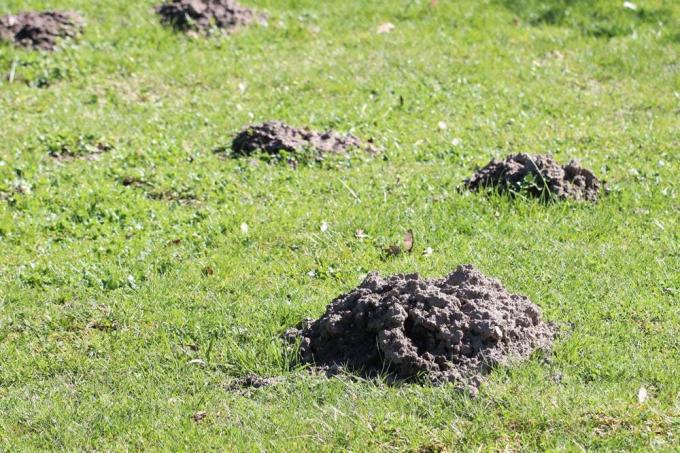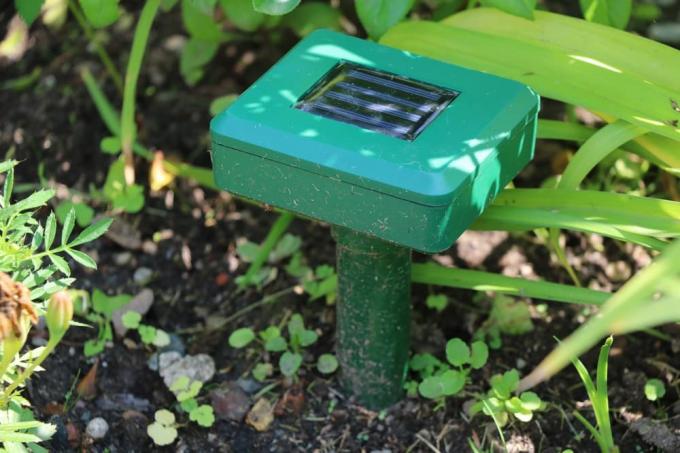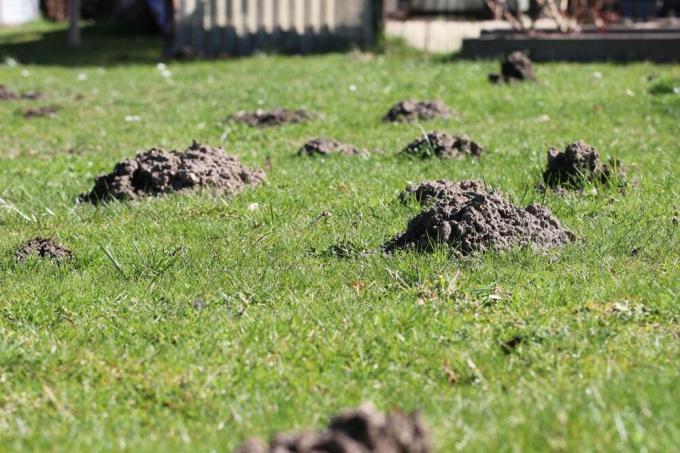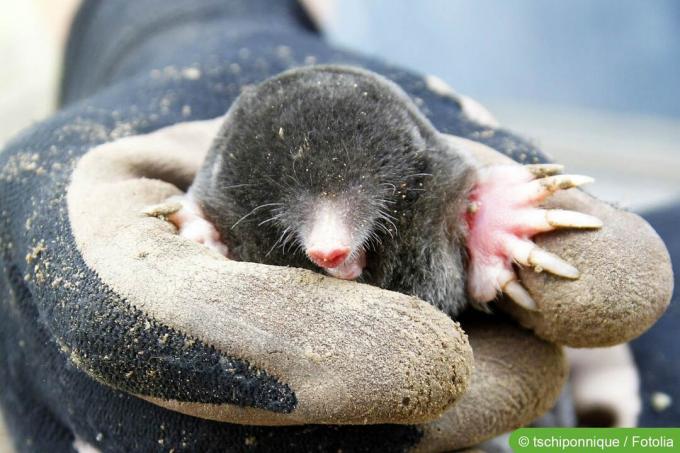

Table of contents
- Caution: Species protection and beneficial
- obstacles
- tones
- deterrence center
- home remedies
- remove hills
- Molehills and garden maintenance
- Conclusion
If molehills appear on the beloved lawn, the anger is often great. The little animals are actually great helpers. Those who still want to drive them away often resort to hard bandages – without any notable success. It is quite possible to eliminate the mounds and get moles to move. And in a very simple way and at low prices. Only the right knowledge needs to be available so that hobby gardeners can enjoy their green oasis without any problems.
Caution: Species protection and beneficial
The mole, or rather its ventilation holes - because that's what molehills are - is usually seen as a tiresome fellow. But it must not be harmed, because it is a protected species in Germany, Austria and Switzerland. The molehills must not be filled with water, surrounded with traps or even trampled on. To put it simply: the resident must not be harmed, otherwise it can quickly become really expensive. In addition, a violation of species protection is also punished legally.
Quite apart from laws and penalties, the mole itself is by no means harmful - quite the opposite. On its way through the soil, the animals ensure good aeration and mixing of the soil. Pests that could be dangerous for the garden serve as their main course. They themselves, on the other hand, do not attack plants and can only slightly injure roots while creating their underground tunnels. Furthermore, the mole is also a seal of quality, because it only settles in good soil. Nevertheless, the raised mounds of earth can of course spoil the optics. However, there is a simple workaround here.
obstacles
If he keeps bumping into obstacles while digging, the mole will quickly lose interest and look for a new environment. Effective prevention can therefore already be built in when laying out lawns and flower beds. Lawn edging stones, root barriers and mole barriers are installed vertically in the ground and separate individual areas from each other underground. Although this involves some effort, it also keeps voles and other burrowing animals away. If the garden is frequently afflicted by these, the work and investment will quickly pay off. Especially since the measure only has to be carried out once and is not a burden on the wallet or the environment.
Tip:
In areas that are still heavily dug up, several lawn edging stones or larger rubble stones can simply be dug in and thus are sunk, so there is no optical disturbance on meadow and Co. The moles are still through the obstacle course deterred.
tones

Electronic devices that emit impulses or sounds keep appearing on the market. The stimulus, which is said to be inaudible to humans, is intended to drive away moles or keep them away from the outset. That sounds simple and logical, but it is usually not successful. In addition, there are some disadvantages resulting from such equipment. The vibrations emitted are by no means silent for all people, especially young people, but also people with sensitive hearing and a tendency to migraines quickly suffer from the high-pitched whistling. The garden thus becomes a source of headaches and not a place of rest and relaxation. In addition, the sound can also be more than unpleasant for your own pets.
Moles and voles, on the other hand, are rarely really impressed by the technology and happily continue digging. It is not uncommon for there to be initial successes, but after a period of getting used to them, the unwanted garden dwellers usually come back.
deterrence center
Also on the market are so-called deterrents for moles, which disturb the sensitive smell of the animals and are supposed to encourage them to move. These are mostly substrate-like substances that are provided with odorants and are spread more or less widely in the garden. In the ground, of course, which in turn means a not inconsiderable effort, because the grains or stones are distributed individually using a spade. This measure must be repeated several times a year if necessary or as a preventative measure. The amount of work and costs are therefore comparatively high here.
In addition, it is often not even stated which odor-intensive biocide the product is. So there is uncertainty in the case of allergies, children playing in the garden and pets.
home remedies
Although moles don't see very well, they can smell all the better. As already mentioned, they are therefore sensitive to odors. This is exactly where the home remedies to drive away the moles can start. Intensely scented or smelly substances do not have to get on the human nose or health and certainly not pollute the environment. Suitable means are:
- crushed garlic cloves or garlic oil
- clove oil
- patchouli oil
- vegetable manure

Fermented milk products and bad fish or spoiled meat are often recommended. With such means, however, other animals could be attracted, while the herbal scents are more than uninteresting even for cats, foxes and Co. In order to drive away the moles, it is better to use them. The procedure is as follows:
- Granules, cat litter or cellulose are impregnated with the smells. Alcohol can also be added as a booster and preservative.
- The fragrance sources prepared in this way are placed directly in the molehills, sprinkled on top of them or placed around them. If a hole is visible in the hill, they can also be placed in the passage below.
- If the corridors are filled with "stench" in this way, the mole will soon run away. No more molehills are added. The impregnated materials do not need to be removed as they are not hazardous and will either disperse or degrade over time.
- With a strong spread of moles, the sources of the odor should also be spread around the house and hills. However, an escape route must remain free so that the animals are driven away by the smell and leave the garden in the desired direction.
Tip:
Once the moles have disappeared, obstacles should be integrated into the garden soil. That way, even after the smell has gone, the animals won't come back.
remove hills
The real annoyance isn't the useful moles, it's the molehills left behind. After the inhabitants of the underground passages have disappeared, they can be eliminated very quickly and easily. There are several measures that can be taken to do this.
- removal with spade or shovel. The dug up soil can be used to fill flower pots, as a growing substrate or for demanding plants, as it is very loose and mostly free of pests.
- Distribute with rake or rake. The earth is distributed until the hill is leveled with the ground. The plants in the area are happy about the high-quality substrate. In the case of lawns, sowing must be carried out again in order to fill in the possibly bare spot.
- wash away with water. With a garden hose, watering can or bucket, the molehills can be removed and the soil distributed. While this is a muddy affair, it's also very easy and quick.
- Fill up. If the mole has disappeared, the molehills may well be leveled. The earth can be tapped flat or pushed back into the ground with pressure. On this occasion, it makes sense to put a few larger stones or a mole trap in the hole as well.
Molehills and garden maintenance
If the molehills are on the lawn, the temptation is great to tackle all the piles of earth with the lawnmower after the small animals have been driven away. After all, the soil would also be distributed or would end up directly in the lawn clippings - a clear work simplification. But this measure can quickly cause more damage than expected. When creating the tunnels and the air holes, moles often move stones to the surface, which are not always immediately visible, but are more than noticeable when mowing. If they get caught in the cutting knives, it becomes dangerous for the blades and bystanders. At least a light distribution by hand or rake is therefore advisable before mowing the lawn.
Conclusion
If you introduce obstacles in the form of lawn edges or mole barriers and, if necessary, use simple but intensive odorants, you can quickly drive away moles. Getting rid of the molehills is just as easy and doesn't require a lot of effort if you do it right.
 garden editorial
garden editorial I write about everything that interests me in my garden.
Learn more about mole

Mole in the garden: good or bad?
If you have a mole in your garden, you can count yourself lucky. Whilst of course they can take a toll on a lawn, they are still an extremely beneficial creature that is guaranteed to benefit the ecosystem behind the house for a long time to come.

Laying a mole barrier - all information for mole grids / mole nets
A mole is a miniature excavator. When he is at work, the garden quickly resembles a construction site. Its small brown mounds of earth pile up in large numbers, exactly where nobody wants them. What use are his good qualities? He has to go!

Chasing away moles – the top 10 tips for scaring away
Molehills on the manicured lawn immediately catch the eye. No garden owner or hobby gardener would want a mole in their own garden. The actually useful animals are under nature protection, for this reason great care must be taken when expelling and deterring them. Under no circumstances should the animals living underground be killed.

Drive away moles gently - all home remedies in comparison
Although a mole is actually a very useful animal because it eats grubs, snails and other pests, it is not a popular garden dweller. Especially not when the painstakingly tended lawns are defaced by molehills. But what is the best way to drive away a mole?

kill mole
It is forbidden to kill the mole and rightly so. The mole has been under nature protection since 1988 and that throughout the year.

Mole Cricket: Should You Fight Them? | Were in the garden
The mole cricket, or Werre, as it is also known, often lives unnoticed in gardens and parks. Because the insect with the scientific name Gryllotalpa gryllotalpa spends a large part of its life underground. Fighting them is only necessary in a few cases.



